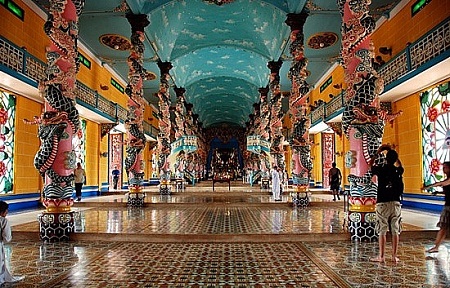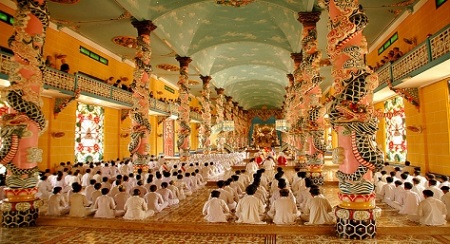- The Cao Dai Great Temple at the sect’s Holy See is one of the most wonderful structures in Asia. Built between 1933 and 1955, this temple is a rococo extravaganza blending the dissonant architectural structure of a French church, a Chinese temple and an Islamic mosque.
- Tay Ninh province, northwest of HCMC, is bordered on three sides by Cambodia. The area’s dominant geographic feature is Nui Ba Den (Black Lady Mountain), which towers above the surrounding plains. The Saigon River forms the eastern border of Tay Ninh province. The Vam Co River flows from Cambodia through the western part of Tay Ninh province.
- Because of the once-vaunted political and military power of the Cao Dai, this region was the scene of long and heavy fighting during the Franco-Viet Minh War. Tay Ninh province used to be a main terminus of the Ho Chi Minh Trail during the American War, and in 1969 the Viet Cong captured Tay Ninh town and then held it for several days.
- During the time of conflict between Cambodia and Vietnam in the late 1970s, the Khmer Rouge set up a number of cross-border raids into Tay Ninh province and committed atrocities against civilians. Many cemeteries around Tay Ninh are stark reminders of these events.
Sights
Cao Dai Holy See TEMPLE
- Home to the Cao Dai Great Temple (Thanh That Cao Dai), the Cao Dai Holy See, established in 1926, is 4km east of Tay Ninh, in the village of Long Hoa. As well as the Great Temple, the complicated houses administrative offices, residences for officials and adepts, and a hospital of traditional Vietnamese herbal medicine that attracts many people from around the south for its treatments. After reunification the government took parts of the complex for its own use (and perhaps to keep an eye on the sect).
- Prayers are conducted four times daily in the Great Temple (suspended during Tet). It’s worth visiting during prayer sessions (the one at noon is most popular with tour groups from HCMC) but don’t disturb the worshippers. Only a few hundred adherents, dressed in splendid garments, take part in weekday prayers but during festivals many thousand may visit.
- The Cao Dai clergy have no objection to visitors taking photos of temple objects, yet remember not to take photo of people without their permission, which is seldom granted. Nevertheless, you can photograph the prayer sessions from the upstairs balcony, an apparent concession to the troops of tourists who come here daily.
- Travellers should wear modest and respectful attire inside the temple, which means no shorts or sleeveless T-shirts.
- The divine eye is set above the front portico of the Great Temple. Lay women enter this temple through a door at the base of the tower on the left. When they go inside they walk around the outside of the colonnaded hall in a clockwise direction. Men will come into the hall on the right and walk around the hall in an anti clockwise direction. People have to remove hats when to enter the building. The area in the centre of the sanctuary is for Cao Dai priests.
- A wall painting in the front entry hall illustrates the three signatories of the ‘Third Alliance between God and Man’: the Chinese statesman and revolutionary leader Dr Sun Yat-sen (Sun Zhongshan; 1866–1925) holds an ink stone, while the Vietnamese poet Nguyen Binh Khiem (1492–1587) and French poet and author Victor Hugo (1802–85) write ‘God and humanity’ and ‘Love and justice’ in Chinese and French (Nguyen Binh Khiem writes with a brush, Victor Hugo uses a quill pen). Nearby signs in English, French and German each give a slightly different version of the fundamentals of Cao Daism.
- The main hall has nine sections by shallow steps, showing the nine steps to heaven, with each level marked by a pair of columns. Worshippers can achieve new step depending on their years as Cao Dai adherents. At the far end of the sanctuary, eight plaster columns entwined with multicoloured dragons support a dome representing the heavens. Under the dome is a giant star-speckled blue globe with the ‘divine eye’ on it.
- The largest of the seven chairs in front of the globe is reserved for the Cao Dai pope, a position that has remained vacant since 1933. The next three chairs are used by the three men important for the religion’s law books. The rest are for the leaders of the three branches of Cao Daism, represented by the colours yellow, blue and red.
- On both sides of the area between the columns are two pulpits similar in design to the minbar in mosques. During festivals the pulpits are used by officials to address the assembled worshippers. The upstairs balconies are used if the crowd overflows.
- Up near the altar are barely discernible portraits of six figures important to Cao Daism: Sakyamuni (Siddhartha Gautama, the founder of Buddhism), Ly Thai Bach (Li Taibai, a fairy from Chinese mythology), Khuong Tu Nha (Jiang Taigong, a Chinese saint), Laotse (the founder of Taoism), Quan Cong (Guangong, Chinese God of War) and Quan Am (Guanyin, the Goddess of Mercy).



